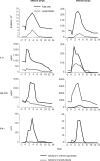Local immune responses in afferent and efferent lymph
- PMID: 10233690
- PMCID: PMC2326739
- DOI: 10.1046/j.1365-2567.1999.00681.x
Local immune responses in afferent and efferent lymph
Figures



Similar articles
-
Studies on the lymphocytes of sheep. II. Some properties of cells in various compartments of the recirculating lymphocyte pool.Eur J Immunol. 1976 Feb;6(2):121-5. doi: 10.1002/eji.1830060210. Eur J Immunol. 1976. PMID: 1085702
-
Immunological events in the popliteal lymph node of sheep following injection of liver or killed Corynebacterium ovis into an afferent popliteal lymphatic duct.Res Vet Sci. 1977 Jan;22(1):105-12. Res Vet Sci. 1977. PMID: 557223
-
Stochastic regulation of cell migration from the efferent lymph to oxazolone-stimulated skin.J Immunol. 2001 Feb 1;166(3):1517-23. doi: 10.4049/jimmunol.166.3.1517. J Immunol. 2001. PMID: 11160191
-
Lymph node homing of T cells and dendritic cells via afferent lymphatics.Trends Immunol. 2012 Jun;33(6):271-80. doi: 10.1016/j.it.2012.02.007. Epub 2012 Mar 27. Trends Immunol. 2012. PMID: 22459312 Review.
-
[The lymphatic system and its functioning in sheep].Vet Res. 1997 Sep-Oct;28(5):417-38. Vet Res. 1997. PMID: 9410334 Review. French.
Cited by
-
Contribution of Extramedullary Hematopoiesis to Atherosclerosis. The Spleen as a Neglected Hub of Inflammatory Cells.Front Immunol. 2020 Oct 26;11:586527. doi: 10.3389/fimmu.2020.586527. eCollection 2020. Front Immunol. 2020. PMID: 33193412 Free PMC article. Review.
-
Orf Virus-Based Vaccine Vector D1701-V Induces Strong CD8+ T Cell Response against the Transgene but Not against ORFV-Derived Epitopes.Vaccines (Basel). 2020 Jun 10;8(2):295. doi: 10.3390/vaccines8020295. Vaccines (Basel). 2020. PMID: 32531997 Free PMC article.
-
Neutrophil Interactions with the Lymphatic System.Cells. 2021 Aug 17;10(8):2106. doi: 10.3390/cells10082106. Cells. 2021. PMID: 34440875 Free PMC article. Review.
-
In Sickness and in Health: The Immunological Roles of the Lymphatic System.Int J Mol Sci. 2021 Apr 24;22(9):4458. doi: 10.3390/ijms22094458. Int J Mol Sci. 2021. PMID: 33923289 Free PMC article. Review.
-
The beta-chemokine receptor D6 is expressed by lymphatic endothelium and a subset of vascular tumors.Am J Pathol. 2001 Mar;158(3):867-77. doi: 10.1016/s0002-9440(10)64035-7. Am J Pathol. 2001. PMID: 11238036 Free PMC article.
References
-
- Butcher EC, Picker LJ. Lymphocyte homing and homeostasis. Science. 1996;272:60. - PubMed
-
- Hay JB, Cahill RNP. Lymphocyte migration patterns in sheep. In: Hay JB, editor. Animal Models of Immunological Processes. London: Academic Press; 1982. p. 97.
-
- Miyasaka M, Trnka Z. Lymphocyte migration and differentiation in a large animal model: the sheep. Immunol Rev. 1986;91:87. - PubMed
-
- Kimpton WG, Washington EA, Cahill RNP. Lymphocyte recirculation and homing. In: Goddeeris BM, Morrison WI, editors. Cell-Mediated Immunity in Ruminants. Boca Raton: CRC Press; 1994. p. 109.
Publication types
MeSH terms
Substances
Grants and funding
LinkOut - more resources
Full Text Sources

